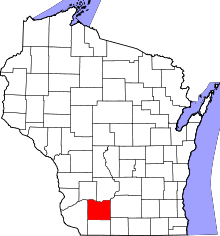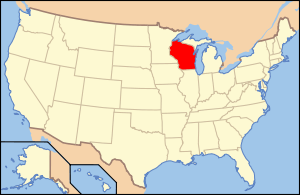Iowa County, Wisconsin
| Iowa County, Wisconsin | |
|---|---|
 Iowa County Courthouse in March 2013 | |
 Location in the U.S. state of Wisconsin | |
 Wisconsin's location in the U.S. | |
| Founded | 1830 |
| Named for | Iowa people |
| Seat | Dodgeville |
| Largest city | Dodgeville |
| Area | |
| • Total | 768 sq mi (1,989 km2) |
| • Land | 763 sq mi (1,976 km2) |
| • Water | 5.4 sq mi (14 km2), 0.7% |
| Population | |
| • (2010) | 23,687 |
| • Density | 31/sq mi (12/km²) |
| Congressional district | 2nd |
| Time zone | Central: UTC-6/-5 |
| Website |
www |
Iowa County is a county located in the U.S. state of Wisconsin. As of the 2010 census, the population was 23,687.[1] Its county seat and largest city is Dodgeville.[2] When created, it was part of the Michigan Territory.
Iowa County is part of the Madison, Wisconsin, Metropolitan Statistical Area.
History


The county organized under the Michigan Territory government[3][4] in 1830.[5] It was named for the Iowa tribe.[6][7]
Geography
According to the U.S. Census Bureau, the county has a total area of 768 square miles (1,990 km2), of which 763 square miles (1,980 km2) is land and 5.4 square miles (14 km2) (0.7%) is water.[8] It is drained by tributaries of the Pecatonica River,[9] which has its headwaters in the county.
Rivers and streams
Major highways
Airport
- Iowa County Airport (KMRJ) serves the county and surrounding communities.
Adjacent counties
- Richland County - northwest
- Sauk County - northeast
- Dane County - east
- Green County - southeast
- Lafayette County - south
- Grant County - west
Demographics

| Historical population | |||
|---|---|---|---|
| Census | Pop. | %± | |
| 1840 | 3,978 | — | |
| 1850 | 9,525 | 139.4% | |
| 1860 | 18,967 | 99.1% | |
| 1870 | 24,544 | 29.4% | |
| 1880 | 23,628 | −3.7% | |
| 1890 | 22,117 | −6.4% | |
| 1900 | 23,114 | 4.5% | |
| 1910 | 22,497 | −2.7% | |
| 1920 | 21,504 | −4.4% | |
| 1930 | 20,039 | −6.8% | |
| 1940 | 20,595 | 2.8% | |
| 1950 | 19,610 | −4.8% | |
| 1960 | 19,631 | 0.1% | |
| 1970 | 19,306 | −1.7% | |
| 1980 | 19,802 | 2.6% | |
| 1990 | 20,150 | 1.8% | |
| 2000 | 22,780 | 13.1% | |
| 2010 | 23,687 | 4.0% | |
| Est. 2015 | 23,813 | [10] | 0.5% |
| U.S. Decennial Census[11] 1790–1960[12] 1900–1990[13] 1990–2000[14] 2010–2014[1] | |||
As of the census[15] of 2000, there were 22,780 people, 8,764 households, and 6,213 families residing in the county. The population density was 30 people per square mile (12/km²). There were 9,579 housing units at an average density of 13 per square mile (5/km²). The racial makeup of the county was 98.70% White, 0.17% Black or African American, 0.11% Native American, 0.34% Asian, 0.01% Pacific Islander, 0.11% from other races, and 0.55% from two or more races. 0.33% of the population were Hispanic or Latino of any race. 33.6% were of German, 17.2% Norwegian, 11.6% English, 11.3% Irish and 7.9% American ancestry according to Census 2000.
There were 8,764 households out of which 34.60% had children under the age of 18 living with them, 59.50% were married couples living together, 7.60% had a female householder with no husband present, and 29.10% were non-families. 24.30% of all households were made up of individuals and 10.10% had someone living alone who was 65 years of age or older. The average household size was 2.56 and the average family size was 3.06.
In the county, the population was spread out with 27.10% under the age of 18, 6.60% from 18 to 24, 30.40% from 25 to 44, 22.50% from 45 to 64, and 13.30% who were 65 years of age or older. The median age was 37 years. For every 100 females there were 99.30 males. For every 100 females age 18 and over, there were 97.70 males.
Parks and recreation
Inside the county are several parks, including Arena Pines-Sand Barrens State Natural Area, Arena Pines-Sand Barrens State Natural Area, Pine Cliff State Natural Area, Blue Mound State Park, Tower Hill State Park, Black Hawk Lake Recreation Area and Governor Dodge State Park.[16][17]
Communities

Cities
- Dodgeville (county seat)
- Mineral Point
Villages
- Arena
- Avoca
- Barneveld
- Blanchardville (mostly in Lafayette County)
- Cobb
- Highland
- Hollandale
- Linden
- Livingston (mostly in Grant County)
- Montfort (mostly in Grant County)
- Muscoda (mostly in Grant County)
- Rewey
- Ridgeway
Towns
Census-designated place
Unincorporated communities
Ghost towns
Notable people
- Gilbert L. Laws, Nebraska Secretary of State and US Congressman[18]
See also
- National Register of Historic Places listings in Iowa County, Wisconsin
- Wisconsin State Natural Areas Program
References
- 1 2 "State & County QuickFacts". United States Census Bureau. Retrieved January 21, 2014.
- ↑ "Find a County". National Association of Counties. Retrieved 2011-06-07.
- ↑ "Iowa County Wisconsin". Wisconsin Travel. Retrieved January 30, 2014.
- ↑ Pioneer Lawmakers' Association of Iowa (1894). Reunion. G.H. Ragsdal. p. 32.
- ↑ "Wisconsin: Individual County Chronologies". Wisconsin Atlas of Historical County Boundaries. The Newberry Library. 2007. Retrieved August 13, 2015.
- ↑ "Profile for Iowa County, Wisconsin, WI". ePodunk. Retrieved January 30, 2014.
- ↑ "Term: Iowa County [origin of place name]". Wisconsin Historical Society. Retrieved January 30, 2014.
- ↑ "2010 Census Gazetteer Files". United States Census Bureau. August 22, 2012. Retrieved August 5, 2015.
- ↑
 Ripley, George; Dana, Charles A., eds. (1879). "Iowa. I. A S. W. county of Wisconsin". The American Cyclopædia.
Ripley, George; Dana, Charles A., eds. (1879). "Iowa. I. A S. W. county of Wisconsin". The American Cyclopædia.
- ↑ "County Totals Dataset: Population, Population Change and Estimated Components of Population Change: April 1, 2010 to July 1, 2015". Retrieved July 2, 2016.
- ↑ "U.S. Decennial Census". United States Census Bureau. Retrieved August 5, 2015.
- ↑ "Historical Census Browser". University of Virginia Library. Retrieved August 5, 2015.
- ↑ Forstall, Richard L., ed. (March 27, 1995). "Population of Counties by Decennial Census: 1900 to 1990". United States Census Bureau. Retrieved August 5, 2015.
- ↑ "Census 2000 PHC-T-4. Ranking Tables for Counties: 1990 and 2000" (PDF). United States Census Bureau. April 2, 2001. Retrieved August 5, 2015.
- ↑ "American FactFinder". United States Census Bureau. Retrieved 2011-05-14.
- ↑ "Iowa County, Wisconsin (WI)". City-Data.com. Retrieved January 30, 2014.
- ↑ "Iowa County Attractions". explore Wisconsin. Retrieved January 30, 2014.
- ↑ "LAWS, Gilbert Lafayette, (1838 - 1907)". Biographical Directory of the United States Congress. Retrieved January 30, 2014.
Further reading
- Commemorative Biographical Record of the Counties of Rock, Green, Grant, Iowa, and Lafayette, Wisconsin, Containing Biographical Sketches of Prominent and Representative Citizens, and of Many of the Early Settled Families. Chicago: J.H. Beers and Co., 1901.
- Crawford, George and Robert M. Crawford (eds.). Memoirs of Iowa County, Wisconsin From the Earliest Historical Times Down to the Present. Northwestern Historical Association, 1913.
- History of Iowa County, Wisconsin. Chicago: Western Historical Company, 1881.
External links
| Wikimedia Commons has media related to Iowa County, Wisconsin. |
 |
Richland County | Sauk County |  | |
| Grant County | |
Dane County | ||
| ||||
| | ||||
| Lafayette County | Green County |
Coordinates: 43°00′N 90°08′W / 43.00°N 90.13°W